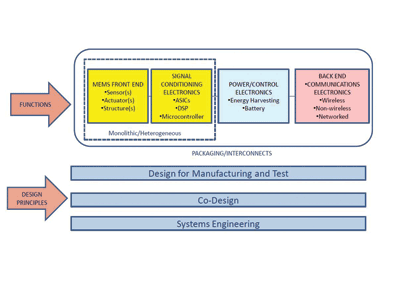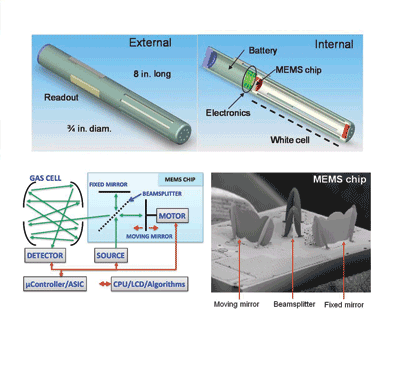Significant reasons have caused MEMS suppliers to change their design approach, thus opening new market opportunities
BY ROGER GRACE
Roger Grace Associates, Naples, FL
www.rgrace.com
and MARYANN MAHER
SoftMEMS, Santa Clara, CA
www.softmems.com
This article, the last in the series “MEMS-Based Systems Solutions,” will address some of the more interesting implementations of the approach. Readers may wish to review the series’ other articles:
“Thinking outside the chip for MEMS design success,” February 2010, ( www2.electronicproducts.com/T-article-farc_grace_feb2010-html.aspx), an introduction to the concept of MEMS-based system solutions and its functionalities and underlying principles, using numerous examples, “Electronics for MEMS: design issues and tradeoffs” ( www2.electronicproducts.com/PageSearch.aspx?F Name=farc_grace_apr2010.html), “MEMS testing: innovations in mass production” ( www2.electronicproducts.com/M-article-farc_stmicro_jul2010-html.aspx), “MEMS: Think outside the chip… at the package level” ( www2.electronicproducts.com/M-article-farc_softmems_nov2010-html.aspx).
The MEMS-based system-solution (MBSS) approach is founded on the basic principles of systems engineering, design for manufacturing and test, co-design, and reliability and involves the functionalities (in addition to the MEMS sensor / actuator / structure front-end) of signal processing, software algorithms, energy creation/storage, wireless or wired networking, and interconnectivity / packaging (see Fig. 1 ). There are many reasons why the approach has been accepted by MEMS suppliers. In addition to the constant need of the microelectronics industry to produce less expensive, more highly integrated solutions with higher functionality, a major reason was the need to differentiate their product while maintaining sufficient gross margins as they were being driven by dramatic commoditization and associated plummeting prices of MEMS devices.

Fig. 1. The MEMS-based system solutions concept embraces the broad range of functionalities (top) and design principles (bottom)
To deal with this situation, suppliers have decided to provide “value-added” features and functions to their products. The most expedient way that they have accomplished this is through software embedded in a microprocessor, whether it exists as a standalone device or resides in an ASIC. A primary role of the software is to increase device performance and add functionality.
The software approach has been adopted by many of the leading providers of inertial sensors, including Freescale (www.freescale.com) ,MEMSIC (www.memsic.com), and STMicroelectronics (www.st.com). MEMSIC CEO Dr. Yang Zhao notes, “We recently acquired the business lines and assets of Crossbow (a wireless systems solutions provider) as a major step to accomplishing the goal of being a provider of more complex, higher-integrated, and function-enriched smart sensing solutions. Here we are combining our MEMSIC MEMS sensor component team’s knowledge with the competencies of Crossbow’s IP, algorithm development, systems integration, and wireless expertise, to develop the next generation multi-sensor systems.” (Crossbow’s attitude-heading-reference system was discussed in this series’ first article.)
Freescale recently introduced a new product line, Xtrinsic, which has adopted this systems solutions philosophy for applications in transportation and mobile-phone gesture recognition. Hillcrest Labs (www.hillcrestlabs.com) (also featured in the Feb. 2010 article) and Movea (www.movea.com) also provides MEMS-based gesture recognition systems too for a wide variety of applications, including consumer electronics.
There are still more opportunities for MEMS-based system solutions in myriad applications, including auto/transportation, consumer, industrial, medical, and military/aerospace. Research conducted by Roger Grace Associates indicates that a number of major applications areas are ripe for development, including structural monitors for machines and buildings, portable analytical instruments, point-of-care health monitors, and consumer electronics.
Structural monitoring
MEMS-based system solutions are presently being explored by a number of organizations to determine the structural integrity of bridges. In the US alone, there are 583,000 bridges which, Professor Jerry Lynch of the University of Michigan’s Wireless Integrated Microsystems (WIMS) Institute (www.wimserc.org) says, “have a baby boomer problem … with age comes deterioration”. The American Society of Civil Engineers reports that approximately 25% of these bridges are structurally deficient or functionally obsolete.
Lynch is part of a WIMS Institute team working on a NIST grant to instrument bridges with accelerometers, collect data, and wirelessly send it to a central platform so that the bridge’s dynamic response can be monitored under actual traffic conditions over time and in real time. MEMSIC (www.memsic.com) and the University of Illinois Urbana-Champaign are also pursuing bridge monitoring, and have instrumented the Jindo Bridge, Korea’s first cable-stayed girder bridge. The monitoring systems constitutes the largest deployed wireless autonomous sensor network (WASN) in the world today.
This monitoring strategy can also be used on roads and other civil engineering structures — including dams, levees, and buildings — particularly in earthquake-prone areas. Further, structural health monitoring is currently being conducted on the fuselages of aircraft by manufacturers such as Boeing and the European Aeronautic and Defense Company (EADS). Prof. Lynch and his WIMS team are also working on an Office of Naval Research/NAVSEA joint project using a WASN approach to monitor the structural integrity of ship hulls made of lightweight materials like aluminum.
A great MBSS opportunity also exists now in “smart building” monitoring. Today, buildings alone consume about 72% of all U.S.-produced electricity, with this number expected to rise significantly. A more detailed description of these applications can be found in the on line version of this article ( www2.electronicproducts.com/W-farc_grace_ feb2011-html.aspx).
Analytical instruments
Analytical instruments offer an exceptional opportunity for the exploitation of MEMS-based systems solutions. The inherent benefits of MBSS — small size, robustness, low power consumption, and low cost, along with surprisingly high performance — suit them ideally to handheld and portable instruments.
These in-field instruments find their way into a broad assortment of applications including Pharma/food/beverage process control quality assurance, environmental monitoring, drug interdiction and homeland security, where they are used to determine the chemical composition of solids, liquids and gases. Strategic Directions International estimates that the total analytical and life sciences market was approximately US $35 billion in 2008, with a compounded annual growth rate of 5% to 6%. While the major share of this market is for benchtop instruments, SDI reports that the portable and handheld market is expected to grow at double-digits CAGR’s in the next five years.
Thermo-Fisher Scientific, (www.thermofisher.com) recently acquired Polychromix, which developed a unique handheld near-infrared (NIR) spectrometer dubbed the micro Phazir. A MEMS-based “optical engine” developed at MIT forms the heart of this highly integrated, robust spectrometer system which, while weighing only 2.75 lbs, performs measurements with accuracies similar to those of benchtop laboratory instruments. Applications for this system include hazardous-materials analysis, counterfeit-material detection, and process quality control.

Fig. 2. Housed in a pen-sized package (top), the battery-operated 8-oz. ChemPen is an accurate, fully integrated FTIR spectrometer (lower left) that uses a MEMS optical engine (lower right) built using Sandia National Laboratory’s SUMMiT-V MEMS processes. Scheduled for broad market introduction in early 2013, it is expected to sell for $1,000 in large quantities.
Block Engineering (www.blockeng.com) is developing its ChemPen Fourier Transform Infrared (FTIR) miniature spectrometer, which is 8 x ¾ in. diameter and weighs 8 oz (see Fig. 2 ). Using a very sophisticated MEMS SUMMiT-V process from Sandia National Laboratory to create its optical engine, “This project, currently at the Technology Readiness Level (TRL) of 4-5, is being funded by the DOD, which has invested over $8 million to date. We expect it to have it commercialized by the beginning of 2013, targeting a selling price of approximately $1,000 each in large volumes,” stated Block’s CEO, Dr. Petros Kotidis.
A more detailed description of these applications is in the on line version of this article ( www2.electronicproducts.com/W-farc_grace_feb2011-html.aspx), along with descriptions of MEMS-based analytical instruments by Thermo-Fisher c2v (www.c2v.nl), Lionix (www.lionixbv.nl), Defiant Technologies (www.defiant-tech.com) and Axsun (www.axsun.com).
These systems are now becoming production realities through the aegis of industry giants including Freescale, STMicroelectronics, and Thermo-Fisher. Expect to see many such systems become commercially available within the next couple of years, driven by the continuing need of the market for higher levels of integration, miniaturization and enhanced functionality.
A great opportunity also exists for small and startup organizations to participate in development and marketing of these systems. There are a number of companies well positioned to leverage their internal MEMS and microelectronics technology competencies to participate in this market opportunity.
Companies including Freescale, MEMSIC, and STMicroelectronics have broad competency in MEMS-device design and manufacturing, as well as a number of other necessary capabilities, such as software algorithm development, ASIC design and manufacturing, and wireless back ends. The challenge they face is to cost-effectively integrate all these functions in a robust package. Let the games begin!
Want to learn more?
The Smart Systems Integration Conference, to be held in Dresden Germany on March 22-23, 2011 (www.smart-systems-integration.org), will address many aspects of MEMS-based system solutions. At the conference, Roger Grace will present “Smart System Integration: Pathway to Enhanced Value Added and Profitability” — a paper that expands on some of the applications in this article. ■
Advertisement
Learn more about Roger Grace Associates





